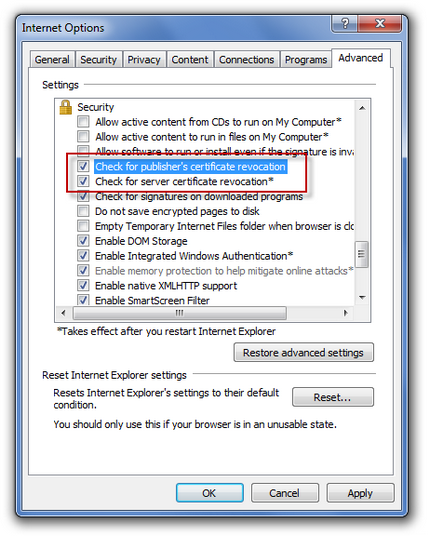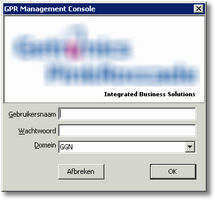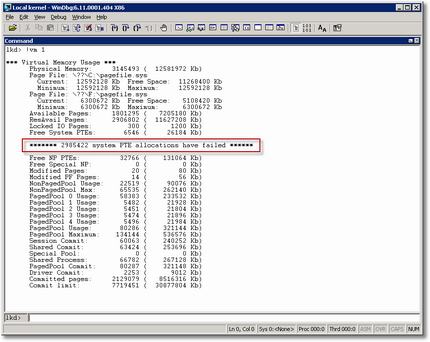Remko Weijnen's Blog (Remko's Blog)
About Virtualization, VDI, SBC, Application Compatibility and anything else I feel like
Archive for the ‘Citrix’ Category
Removing the Uninstall or change a program button from the Explorer Command Bar
Author: Remko Weijnen25 Nov
Windows Vista introduced the Command Bar in Explorer which is sometimes also referred to as the Folder Band or the Task Band. The Command Bar is of course also present in Windows 7 and Server 2008 (R2).
This Command Bar shows possible tasks or actions depending on the active folder. I wanted to remove the “Uninstall or change a program” (in Dutch this is called “Een programma verwijderen of wijzigen”) button from the Computer view:
Unattended Install of the Citrix Xenapp WebInterface 5.2
Author: Remko Weijnen17 Nov
I noticed that XenApp 5 Feature Pack comes with a new version of the Web Interface (5.2) (it is also available as standalone download). The parameters to install it in silent mode have changed but there’s no documentation at all on the Citrix Site:
Adding a Printer Connection with an alternative driver
Author: Remko Weijnen16 Nov
I needed to add a printer connection to a Citrix server but the problem was that this printer had a buggy driver. I wanted to use an alternative driver such as the Citrx Universal Printer driver but on Terminal Server you might want to use the Terminal Services Easy Print driver.
So I decided to make something that could be used in both situations, the result is a small commandline tool called AddPrinter2 (sorry I am not good in finding original names).
It takes 2 parameters: the printername as unc path and the driver name. An example would be:
AddPrinter2 “\\server\printer” “Citrix Universal Printer”.
Slow Installation because of Certificate Checks
Author: Remko Weijnen6 Nov
A few days ago I noticed that an unattended installation of Citrix XenApp 5 was installing very slowly. When I looked at the various jobs and their installation time in the (Altiris) Deployment Server I saw that it was the Citrix Access Management Console that took almost 45 minutes to install:
It was clear that this wasn’t normal since the install job is taking installing OS components like IIS and all subcomponents, activating Application Server and reboot in around 9 minutes. The installation of Citrix XenApp itsself takes only 14 minutes.
I searched with Google and one of the first links was this knowledge base article from Citrix: Slow Access Management Console Installation on XenApp 5.0. The article clearly describes that the delay is occurred by failing checks for Publisher’s and Server Certificate Revocation (because there’s no Internet Connection) and suggests to turn these checks off. Indeed my servers do not have a direct internet connection so the cause and solution were clear.
And actually I had seen similar issues before in other (non Citrix) installations, some examples are Exchange 2007 (here and here) and SQL Server 2008 (the SQL Installer actually checks if there’s an internet connection in the prerequisites check).
The suggested, manual way, of turning of these checks is to clear the following checkboxes in Internet Explorer’s advanced settings Dialog:
But since I had to do this on many servers I decided it would be better to do it with a little VBS script.
Windows Installer proxy information not correctly registered
Author: Remko Weijnen5 Nov
I was deploying an unattended installation of Citrix XenApp 5.0 with Altiris Deployment Server. The installation consists of several prerequisites, the installation of XenApp and finally the Citrix Management Consoles.
The installation is performed with a special account and not the Local System account because the install packages are located on the network.
When testing the deployment on a Windows Server 2008 I noticed that sometimes MSI based installations would fail with error code 1603 or 1601.
Delegated Management Console
Author: Remko Weijnen12 Jun
In this topic I just want to show(case) you something I created in the past. It is a management console that enables delegated management in a Terminal Server or Citrix environment.
The console is launched by a small executable that check credentials (based on group membership) and then launches an RDP session with the actual console in it. The logic behind it is that the RDP session runs with an account with delegated permissions in Active Directory and the actual user account that logs in here doesn’t have any permissions at all.
This is the login screen:
If you’ve passed the login screen you enter the Main Console which consists of a Treeview on the left with possible options and a work area on the right:
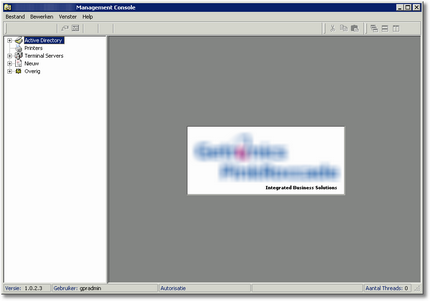
Citrix Desktop Switcher
Author: Remko Weijnen12 Jun
A while ago I wrote a small tool to assist in switching between a Full Screen Citrix Desktop and the local desktop. By default the Citrix client can switch from full screen to windowed mode (with the SHIFT F2 hotkey) but it doesn’t minimize the window automatically. So this always requires manually minimizing, do your local work, give focus to the Citrix client again and press the hotkey again to return to full screen.
My idea was really simply: we write a little exe that runs locally and registers the SHIFT F2 hotkey. When the Hotkey is pressed we determine if we are in full screen or in windowed mode and reverse that. When going from Full Screen to Windowed we minimize the Citrix Client and notify the user (by balloon tip) that he is on the local desktop. I called it the Citrix Desktop Switcher (sorry I couldn’t come up with a more original name)
So let’s see it in action!
When you start the Citrix Desktop Switcher you are notified that the tool is running (it doesn’t matter when you start the Switcher, you can start if even if the Citrix Session is already running).

Modifying Microsoft Updates and/or hotfixes
Author: Remko Weijnen12 May
As you might know Microsoft distributes updates and hotfixes with in installer, update.exe. When you run update.exe it looks into the supplied .inf files to see what it has to install. It’s not possible to make changes to the inf files however because that will invalidate it’s signature (and update.exe checks the signature that is stored in an accompanying .cat file).
In my case I wanted to deploy the MUI pack for Internet Explorer 7 to be able to support multiple languages. By default this pack installs 35 (!) languages and I wanted to install only Dutch language on top of existing English.
Unable to get System PTE individual lock consumer information error when using !sysptes 4 in WinDbg
Author: Remko Weijnen16 Apr
A few days ago I was troubleshooting some strange problems on a Citrix Server. After some investigation (I will write about that later) it was clear to me that there was a shortage of System Page Table Entries (PTE’s). Using perfmon you can see how many free System PTE’s are available:
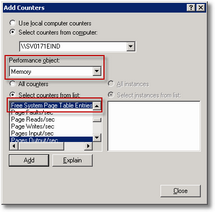
Any value below 5000 is not good, values below 2000 are critical. In my case it wasn’t possible to view processes with Task Manager anymore.
Next I used WinDbg and attached to the Kernel (you can do that with File | Kernel Debug | Local | OK) and issued the !vm command:
WinDbg shows us a warning that a lot of PTE allocations have failed, we can also see that there’s enough Paged Pool and Non Paged Pool available.
So how do we find the guilty driver (usually it’s a driver)? (more…)
Sending Ctrl-Alt-Del / Simulate SAS in Windows Vista
Author: Remko Weijnen30 Mar
Existing code to simulate the Secure Attention Sequence (SAS),which most people refer to as control alt delete or ctrl-alt-del, no longer works in Windows Vista. It seems that Microsoft offers a library that exports a function called SimulateSAS(). It is not public and one is supposed to request it by sending a mail to saslib@microsoft.com. Mails to this address remain unanswered though.
I researched how other people (including Microsoft) have solved this task and was unhappy with the results: some solutions work only with (or without) UAC, most solutions work only for the current or console Terminal Server sessions or need a kernel mode driver.
So I decided to create my own Saslib with the following goals:
- Should work both with and without User Account Control (UAC)
- Should support current, console and any Terminal Server session
- Does not need a driver
- The calling application does not need to be signed or have a special manifest
- Support multiple programming languages
I have succeeded and thus SasLibEx was born: not only can it successfully simulate the SAS sequence it can do this for any/all Terminal Server sessions. It can also lock the workstation (again for all sessions) and switch between the normal desktop and the secure desktop (the desktop that UAC runs on). SasLibEx was successfully tested both with and without User Account Control (UAC).
In the future I will place SasLibEx on it’s own website. Meanwhile you can contact me if you are interested in it at the following mail address: 
Please note that I have spend lots of time into this project and therefore I cannot give it away for free
Update: I have added new features to SasLibEx, see here: https://www.remkoweijnen.nl/blog/2009/04/07/saslibex-updates/
Profile
Top Posts
- Query Active Directory from Excel
- RNS 510 Startup Logo–My thoughts
- Adding a hidden Exchange mailbox to Outlook
- How rdp passwords are encrypted
- Get Actual CPU Clock Speed with PowerShell
- ClickOnce Applications in Enterprise Environments
- VW RNS 510 Navigation Startup Pictures
- Unattended Installation of IBM System i Access for Windows
- Reading physical memory size from the registry
- Show Client IP Address when using NetScaler as a Reverse Proxy
Recent Comments
Featured Downloads
- AClientFix (13595 downloads )
- AddPrinter2.zip (12854 downloads )
- AdProps (12379 downloads )
- AdSample1 (11432 downloads )
- AMD Radeon Crimson ReLive (29488 downloads )
- Atheros Driver (34019 downloads )
- AutoLogonXP 1.0 (11404 downloads )
- CDZA (9560 downloads )
- ChDrvLetter.zip (11217 downloads )
- ChDrvLetter.zip (14356 downloads )
Blogroll
- Andrew Morgan
- Arnout’s blog
- Assa’s Blog
- Barry Schiffer
- Delphi Praxis
- Ingmar Verheij
- Jedi Api Blog
- Jedi API Library
- Jeroen Tielen
- Kees Baggerman
Categories
- .NET (4)
- Active Directory (28)
- Altiris (36)
- App-V (1)
- Apple (5)
- Application Compatibility (11)
- Automotive (5)
- AWS (1)
- BootCamp (1)
- C# (6)
- C++ (2)
- Citrix (87)
- Delphi (61)
- Embedded (4)
- Exchange (16)
- General (71)
- iPhone (5)
- Java (8)
- Linux (1)
- Lync (2)
- NetScaler (1)
- Oracle (4)
- Other (1)
- Packaging (19)
- PowerShell (56)
- Programming (79)
- Quest (1)
- RES (7)
- script (22)
- ShareFile (1)
- SQL Server (10)
- Strange Error (3)
- Terminal Server (68)
- ThinApp (3)
- ThinKiosk (1)
- Ubuntu (1)
- Unattended Installation (19)
- Uncategorized (51)
- UWP (2)
- Vista (37)
- Visual Studio (1)
- VMWare (26)
- Windows 10 (2)
- Windows 2003 (30)
- Windows 2008 (37)
- Windows 2008 R2 (16)
- Windows 2012 (2)
- Windows 7 (30)
- Windows 8 (4)
- Windows Internals (12)
- Windows XP (16)
Archives
- February 2023 (1)
- October 2022 (3)
- July 2022 (1)
- June 2022 (2)
- October 2019 (1)
- March 2018 (1)
- January 2018 (4)
- December 2017 (3)
- April 2017 (1)
- March 2017 (5)
- February 2017 (4)
- May 2016 (3)
- March 2016 (1)
- October 2015 (2)
- September 2015 (1)
- January 2015 (1)
- August 2014 (1)
- July 2014 (8)
- May 2014 (1)
- November 2013 (1)
- October 2013 (2)
- September 2013 (3)
- August 2013 (4)
- June 2013 (2)
- May 2013 (3)
- April 2013 (5)
- March 2013 (5)
- February 2013 (1)
- January 2013 (5)
- December 2012 (9)
- November 2012 (3)
- October 2012 (3)
- August 2012 (4)
- July 2012 (2)
- June 2012 (1)
- May 2012 (6)
- March 2012 (13)
- February 2012 (12)
- January 2012 (9)
- December 2011 (9)
- November 2011 (4)
- October 2011 (5)
- September 2011 (10)
- August 2011 (10)
- July 2011 (2)
- June 2011 (8)
- May 2011 (12)
- April 2011 (4)
- March 2011 (14)
- February 2011 (8)
- January 2011 (32)
- December 2010 (23)
- November 2010 (19)
- October 2010 (10)
- September 2010 (6)
- August 2010 (1)
- July 2010 (1)
- June 2010 (6)
- March 2010 (7)
- February 2010 (3)
- December 2009 (3)
- November 2009 (11)
- September 2009 (2)
- July 2009 (1)
- June 2009 (5)
- May 2009 (1)
- April 2009 (2)
- March 2009 (3)
- February 2009 (6)
- January 2009 (3)
- December 2008 (8)
- November 2008 (5)
- October 2008 (3)
- September 2008 (3)
- August 2008 (3)
- June 2008 (6)
- May 2008 (2)
- April 2008 (3)
- March 2008 (5)
- January 2008 (3)
- December 2007 (3)
- November 2007 (13)
- October 2007 (10)




